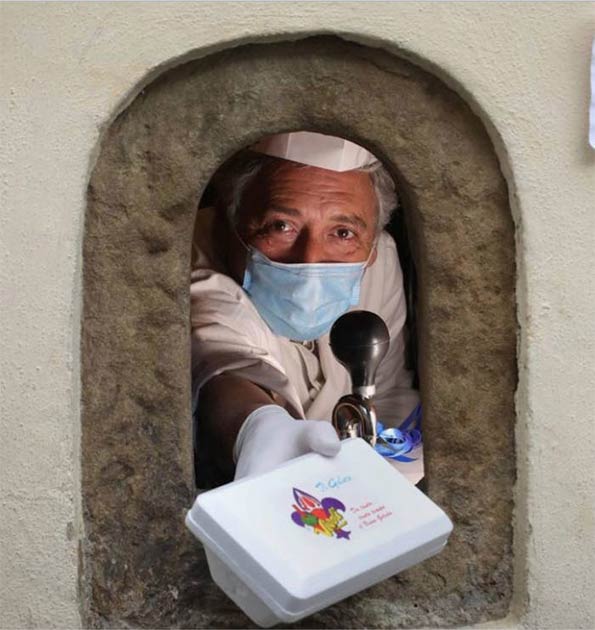
Medieval ‘Wine Windows’ Revived Due to Coronavirus
An old tradition has been revived in Florence, Italy due to the COVID-19 crisis. Once again wine windows have been opened to serve customers in one of Italy’s most beautiful cities. This tradition dates back to the Middle Ages when the plague was a part of everyday life. The wine windows are once again in use during the COVID-19 pandemic and allowing people to enjoy refreshments safely.
There are many architectural masterpieces in Florence such as the Uffizi Gallery and the Duomo. However, one architectural feature which has been largely forgotten is the wine windows, which are known as ‘buchetta del vino’ in Italian. They are little hatches in walls of historic houses, that were once the dwellings of the Florentine elite.
These wine windows were originally made to sell cheap wine to the Florentine poor and working-class from at least the 16th century. There are about 150 of them within the city walls and there are more in its hinterland.

A cocktail being served through the wine window of the Osteria delle Brache in Piazza Peruzzi. (Associazione Buchette del Vino)
Wine Windows to Serve in a Time of Plague
There is a dedicated association to the conservation and promotion of these hatches which is called the Wine Windows Association. Its president, Matteo Faglia, said that “People could knock on the little wooden shutters and have their bottles filled.” Often the wine was sold by some of the best-known Italian wine-making families, such as the Antinori and Ricasoli.
The wine windows were originally constructed in response to the ever-present threat of illness and plague in Florence. During the Black Death, in the 14th century, as much as half of the city’s population died. In the following centuries plagues and epidemics of infectious diseases such as smallpox would regularly kill many people.

“People could knock on the little wooden shutters and have their bottles filled.” (Steve Lovegrove /Adobe Stock)
Mr. Faglia observed that those who constructed the hatches “understood the problem of contagion.” The wine would be passed out the window and payment would be placed on a small plate so that the seller would not have to touch the customer’s coins.
The Fear of Contagion
Often the buyer would only buy the wine and had to return the flask. Naturally, in a time of plague the wine-seller did not want the returned container for fear of becoming infected. To overcome this the president of the Wine Window Association stated that “the client was allowed to fill his or her flask directly by using a metal tube which was passed through the wine window, and was connected to the demijohn on the inside of the palace.” Other purveyors of wine would only sell bottled vintages during epidemics and plagues.
The custom remained popular well into the 20th century. The New York Post quotes Mr. Faglia as saying that “The wine windows gradually became defunct, and many wooden ones were permanently lost in the floods of 1966.” However, they are making a comeback thanks to the restrictions currently in place in response to the Coronavirus pandemic, which requires social distancing. Italy has been one of the countries worst hit by the current pandemic, with 35,000 fatalities.
Social Distancing but Still Selling Cocktails, Wine, and Ice Cream
In times of crisis people improvise, and Florentine business owners are using their wine windows to boost their business in the time of COVID-19. Several wine shops have reopened the hatches for the first time in ages.

“The wine windows gradually became defunct, and many wooden ones were permanently lost in the floods of 1966.” (Steve Lovegrove /Adobe Stock)
They are being used to serve a variety of refreshments and not just the excellent local Tuscan wines. An ice cream parlor in the heart of historic Florence now sells ice cream and gelato from its window. One intrepid entrepreneur has even begun to sell cocktails to thirsty locals and tourists.
- Origins of the Magnificent Florentine Cathedral Santa Maria di Fiore
- Mass grave discovered under Uffizi Gallery in Florence
- Bones from the wealthy and privileged Medici children show they suffered from malnutrition
The wine windows are a great way to ensure that social distancing is being observed. This can help to reduce the rate of transmission of the virus. Local people are relishing an opportunity to enjoy a stiff drink after almost two months of lockdown.
Moreover, the wine windows are proving to be a hit with visitors. They are taking selfies at the wine windows and putting them on their Instagram, Snapchat, and other social media platforms. The once-forgotten hatches in the wall are now known around the world.

Centuries-old wine windows found across the city have been reopening as an innovative way to serve food and cocktails. (Associazione Buchette del Vino)
Will Wine Windows Stay Part of the New Normal?
The Wine Window Association hopes that Florentines and visitors will now appreciate these historic hatches. The president of the association stated to Insider that “We want to put a plaque by all the wine windows” to raise awareness of this unique Florentine tradition.
It is also possible that the wine windows may be in use for some time because of the societal changes due to the worst global pandemic since the Spanish Flu (1918-1920).
Top image: A wine window (buchetta del vino), used in the past to sell wine directly to passers-by, on the old stone wall of an ancient building in the historic centre of Florence, Tuscany, Italy. Source: Simona Sirio /Adobe Stock
By Ed Whelan
















Comments
There’s not a new thing under the Sun
Everything old is new again. And, useful.